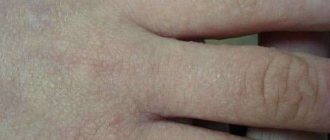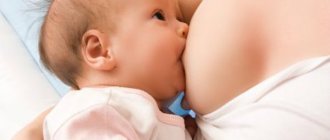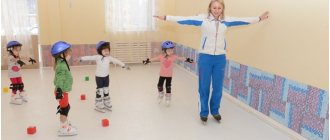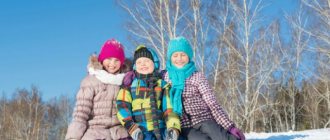Causes of spots
Why does your baby's skin become dry and spots appear:
- Hormonal imbalance in the body of a newborn. It leads to the appearance of a red rash and roughness of the skin - this is how acne appears in a baby (see also: acne on the face of a baby). As soon as the hormones return to normal, and this usually happens by one and a half months, the baby’s skin will again become clean and smooth.
- Dry spots in a child may appear as a result of the negative influence of external factors:
- dry air and lack of fluid in the body;
- lack of vitamins;
- poor water quality or excessively drying bath infusions (chain, chamomile, oak bark);
- roughness appears under the influence of wind or frost (mainly exposed parts of the face and body suffer);
- too frequent use of shampoo: despite the high quality of the product, frequent washing can cause dry scalp;
- when a mother uses powder too actively, it can unnecessarily dry out the delicate thin skin of the baby’s bottom.
The reason may lie in genetic pathology. Such hereditary manifestations of roughness make themselves felt at 2-3 years of age, usually no later than 6 years:
- Ichthyosis. Cells become horny as a result of mutations at the gene level: dry skin eventually becomes covered with white or gray scales, eventually the whole body becomes covered with “fish scales.” In addition to skin problems, internal ones are also added: malfunctions of organs, metabolic disorders. Photos of white scales can be found on the Internet.
- Hyperkeratosis. The epidermis thickens excessively, the skin becomes horny. Most often, these anomalies are recorded on the hips, feet, elbows and head. What is the cause of this disease? Scientists cannot yet give a definite answer. In addition to hereditary predisposition, other factors are also important: lack of vitamins E, C and A, dry skin, the consequences of taking hormonal drugs, stressful situations, hormonal imbalance during teenage puberty, too long exposure to ultraviolet rays, gastrointestinal diseases, the result of exposure to drugs cleaning, washing, washing.
- Helminthiases.
- Atopic or exudative dermatitis. It is he who in most cases is the culprit of bright pink and rough cheeks and butts. The appearance of rough white or red spots above the lip and on other parts of the body is his “hands”. The root cause of this disease is allergic reactions.
Causes of rough skin in children
Newborn acne can cause the sudden appearance of red rashes on the face and dry, rough skin. This is caused by an excess of hormones in the newborn’s body. Until the age of two months, this is quite normal and goes away on its own.
If the child is already more than two months old, and the rashes on the body have not gone away and even increased, forming dry spots, then this may be signs of atopic dermatitis caused by external irritants. External irritants include the baby's food (various dry formulas and even mother's breast milk). The mother should monitor her diet, taking care of the child’s health. Many allergens (dust, cosmetics, animal hair, washing powder, medications, etc.) can also cause atopic dermatitis on a child’s skin. Even dry air in your apartment can become an external irritant. Unfortunately, nowadays an increasing number of newborn children suffer from manifestations of atopic dermatitis.
Frequent walks with a newborn in windy and frosty weather can also cause rough skin. The exposed parts of the baby’s body suffer the most from this: the face and hands.
However, only a doctor can make an accurate diagnosis and indicate the cause of the child’s rough, red skin and prescribe the correct treatment. Parents can treat their baby's skin at the first sign of rashes, as well as to prevent and prevent the disease.
Lichens of different types
White, pink or red spots with a dry crust on a child's body may be lichen. They are pityriasis, pink, scaly, white. The types of this skin disease differ in the causes of appearance, severity, as well as color, shape and size. Below are detailed descriptions of each type of lichen with photos.
Pityriasis versicolor
The development of this disease is provoked by yeast-like fungi. Factors influencing the appearance of this type of lichen:
- staying in countries with a hot climate (hence another name for the disease - “sun fungus”);
- close, intimate and prolonged contact with an infected person;
- weakened immunity;
- overuse of antibacterial skin care products;
- increased sweating;
- disruption of the endocrine system.
The child develops dry spots on the body, the structure of which resembles bran. As a rule, small spots with clear outlines are localized in the upper part of the body: on the shoulders, neck, elbows, chest, armpits, back and abdomen. They are often dark, reddish-brown in color. The affected areas do not tan, so they look light against the background of tanned healthy skin.
Pityriasis rosea
The causative agent of this infectious-allergic skin disease is currently unknown. Children over 10 years of age are most often susceptible to infection. Favorable conditions for the appearance of pityriasis rosea, which is not a contagious disease, are infections and a decrease in the body's defenses.
The disease begins with the appearance in the child of a so-called maternal plaque - a single nodular formation of a pinkish tint. The apical part of the papule, the diameter of which reaches 2 cm or more, becomes yellow over time. Having acquired a rough surface, it begins to peel off.
Usually, 2–3 days after the appearance of the first nodule, multiple 0.5–1 cm oval-shaped pink spots appear on the child’s torso, arms and legs. Then barely visible folded scales appear in the center of the spots. This type of lichen does not require specific treatment and goes away on its own within a month.
Scaly (psoriasis)
Young children very rarely get sick with this chronic non-infectious disease, presumably of autoimmune origin. Children over 15 years of age are most susceptible to infection. The disease is characterized by the formation of red, raised spots with a dry surface, which, merging, form large areas of skin elements - psoriatic plaques.
Excessive proliferation of epidermal keratinocytes in them, as well as macrophage and lymphocytic infiltration of the skin lead to thickening of the affected areas of the skin. As a result of this, they begin to rise above the surface of the healthy epidermis and acquire a light, gray or silver tint.
Initially, psoriasis, as a rule, affects those areas of the body that are often subject to friction and compression - the extensor surface of the elbows, knees and buttocks. The disease can also spread to the palms, scalp, feet, and external genitalia. There are often cases when the disease affects the nail plates on the feet and hands (psoriatic onychodystrophy).
Pityriasis alba
People at risk for contracting this type of skin disease include:
- people with dark skin color;
- persons suffering from allergies and autoimmune pathologies;
- children under 10 years of age, including newborn babies;
- adolescents in puberty.
The disease is characterized by the appearance of depigmented areas of skin on the lateral surface of the shoulders, arms, thighs, as well as in the area around the eyes, mouth, ears, nose, and anus. Most often, white peeling spots, the size of which reaches 4 cm or more, appear in children in the summer and spring. In most cases, lichen simplex does not require treatment and will go away on its own over time.
Causes of rough spots
Dry spots on a child's skin can appear for a number of reasons. The most common ones include the following.
Exudative diathesis
The baby's body can react with skin rashes to exudative diathesis. With this disease, the scalp begins to peel off first. Seborrheic scales appear on the crown of the newborn. As the disease progresses, diaper rash appears on the body. The stomach especially suffers. The face begins to turn red, and rough patches form on it.
The causes of the development of the disease are most often an incorrectly selected formula for artificial feeding, too early introduction of complementary foods, or an individual reaction to a certain product.
Important! If the factor that provoked the development of exudative diathesis is not identified in a timely manner, the disease can become chronic.
Allergic diathesis
The appearance of red, rough spots on a child’s body may also be associated with allergic diathesis. Its symptom is roughness on the child's face, body, arms or legs. Most often, the disease is caused by the following factors:
- allergic reaction to a product or external irritant;
- heredity;
- infection;
- taking certain medications by the mother during pregnancy or breastfeeding.
There is no need to treat allergic diathesis - it is enough to simply eliminate the allergen, and the symptoms will subside over time.
Diathesis is a very common childhood diagnosis.
Psoriasis (scaly lichen)
An infant diagnosed with psoriasis is a relative rarity in medicine. If pathology does develop, it is more likely than in adults to be severe and cause complications. Most often, flaky, dry spots on a child’s skin appear against the background of reduced immunity due to the disease. This happens after infectious diseases, chickenpox or flu.
Psoriasis rashes can affect any part of the body, be it the leg, arm, elbow, etc. You should definitely seek help from a doctor when the first rash appears. Moreover, when a baby suffers from psoriasis, additional symptoms are often observed. The child’s health deteriorates and he begins to itch. Scratching the skin, in turn, leads to injury and the formation of new lesions. This greatly increases the risk of infection.
Important! In advanced cases, psoriasis can spread to the mucous membranes of the mouth or external genitalia.
Roseola rosea
Sometimes the appearance of dry pink spots on the skin of a baby is explained by roseola rosea (sudden exanthema). Doctors do not make this diagnosis to babies very often. We are talking about an infectious disease transmitted through the air or the fecal-oral route. Most often, the disease is caused by herpes viruses.
Children in the age range from three months to two years are most susceptible to roseola rosea. The description of the symptoms is in many ways similar to the signs of acute respiratory viral infection, only a small rash with a pink or reddish tint is added to the elevated temperature, catarrhal symptoms and weakness.
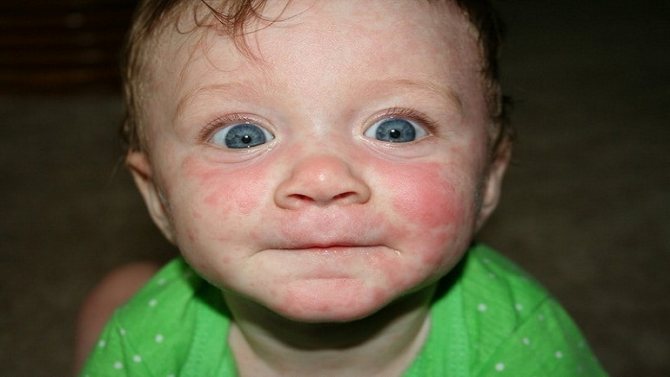
Roseola rosea can cause great discomfort to babies
Important! Immunity is developed to roseola rosea. If a child has had it at one year of age, the likelihood of re-infection is incredibly low.
Contact dermatitis
If a newborn or baby has skin rashes in the first month of life, most often the cause is contact dermatitis. It mainly develops when the diaper rubs against the delicate skin of the butt or tummy area. It can also appear if the baby is bathed in chlorinated water. In addition to the above, contact dermatitis can be caused by the following factors: detergents, medications, household chemicals, cosmetic or hygiene products, poisonous plants and some metals.
When exposed to strong external agents, the disease can have four stages:
- Superficial lesion with limited redness of the skin.
- Severe damage with the formation of blisters, the contents of which are white or colorless.
- Destruction of the skin structure with tissue necrosis.
- Damage to all parts of the skin and underlying layers.
For your information. An infant with contact dermatitis becomes capricious, eats poorly, and sleeps restlessly.
Lichens of different types
The appearance of dry crusts on the body of a baby can be explained by pityriasis versicolor, pink or white lichen. The indicated diseases have different causes of development, severity, and the nature of the rash.
With pityriasis versicolor, dry skin increases. As the disease progresses, the number of dry spots on the baby's skin becomes greater. In their structure they strongly resemble bran. The disease often occurs when the climate changes, when the baby’s body is weakened. When exposed to the sun, the affected areas of the body will remain untanned.
Rough sores are a sign of helminthic infestation
Children are among the main risk groups for contracting parasitic infections. Intoxication of a child's body with waste products of parasites, among other symptoms, often manifests itself in the form of damage to the epidermis by elements with a rough surface. In addition to spots on the skin, you can determine that worms have settled in the child’s internal organs by a number of other signs:
- deterioration or complete loss of appetite;
- weight loss;
- fatigue;
- weaknesses;
- painful sensations in the navel area.
In advanced forms, the disease in children is accompanied by cough, symptoms of bronchitis and allergies. Parasitic infections most often develop due to failure to comply with basic hygiene rules, consumption of dirty foods, and close contact with domestic or street animals that have not undergone anthelmintic treatment.
Roseola rosea
This infectious disease, the causative agents of which belong to the group of human herpes viruses type 6 and 7, is mainly diagnosed in children under 2 years of age. The disease is transmitted by airborne droplets. The peak incidence occurs in the spring and early summer season.
After the body temperature normalizes within 24 hours, small pinkish rashes appear on the child’s torso. In this case, the baby does not experience pain. He is still active. In most cases, the rash goes away on its own within 4–7 days.
How to treat and when can’t you do without a doctor?
Treatment in each case is strictly individual and depends on the cause that caused the spots on the child’s skin. To get rid of some rashes, it is enough to adjust your diet, replace personal hygiene products and eliminate the allergenic factor; to eliminate others, long-term use of potent drugs may be necessary.
The well-known children's doctor E. O. Komarovsky, who enjoys well-deserved authority among fellow pediatricians, categorically does not recommend that parents self-medicate if dry spots are detected on the baby's body.
An immediate visit to the doctor is required in cases where, in addition to skin rashes, the following symptoms are present:
- chest pain;
- fainting and delirious state;
- breathing problems;
- increase in body temperature to high levels, which cannot be brought down on your own;
- runny nose;
- signs of anaphylactic shock.
How to help your child
When parents notice that their baby’s skin has become dry, the first thing they need to do is eliminate possible provoking factors:
- humidify the air in the room;
- give a drink;
- treat with an emollient.
Further actions depend on the location of the dry area and the extent of the damage.
Self-treatment is possible only if the dryness has occurred recently, does not cause discomfort and is not accompanied by inflammation and high temperature.
Peeling on the butt
Most often, children under one year of age have peeling buttocks. Noticing this, the mother should:
- remove the diaper and forget about it until the skin becomes normal;
- treat the skin with baby cream, oil or Bepanten (powder should not be used);
- change diapers as soon as the baby goes to the toilet;
- “holop” if the temperature allows.
Dry feet and hands
The skin on your feet may become dry due to tight shoes, synthetic liners or socks. This sign may indicate a fungal infection.
To prevent the disease from starting, you need to:
- wash your feet with soap;
- wipe dry;
- lubricate with baby cream and put on cotton socks.
Shoes should be replaced with open ones, and in winter they should be insulated with natural fur; the child should wear cotton tights (socks). If the dryness does not go away, and cracks and inflammation appear, you need to take the child to a dermatologist.
Dry skin on a child’s hands can be softened with special baby creams, but if they do not help, you need to consult a doctor. This symptom is inherent in many diseases; only a doctor can identify them and prescribe treatment.
Face and head
In newborns, you can often observe dry skin on the face, these are remnants of vernix lubrication. The resulting scales cannot be removed; they will disappear on their own in a few days.
Dry skin on the cheeks is often a sign of allergies or chapping. To alleviate the child’s condition, you need to lubricate them with cream before going outside and review their diet.
Dry, flaky skin on the eyelids and near the mouth can signal viral or ophthalmological diseases, in this case you need to visit a pediatrician; self-medication can lead to serious complications.
Almost every baby in the first months of life has a dry seborrheic crust on the head, which is not a pathology, but it cannot be ignored. This film reduces the access of oxygen to the skin, causing hair to grow poorly or fall out. Remove it only in a softened form after bathing or lubricate it with oil.

